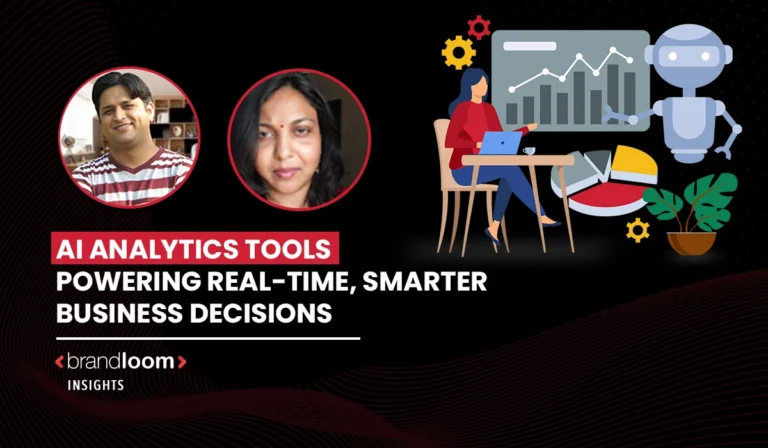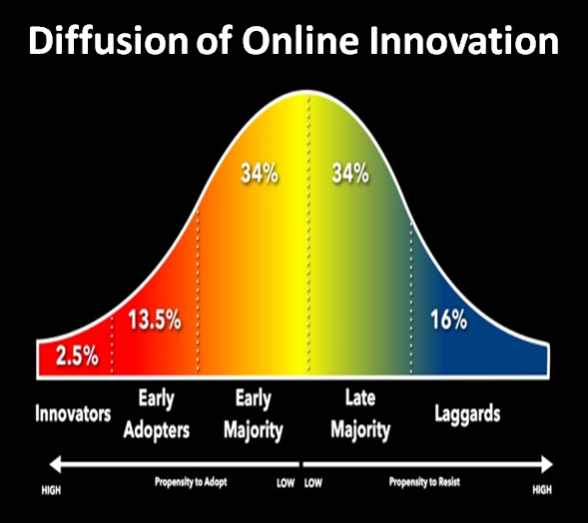Every business collects data. But only the smart ones know how to use it in real time.
The truth is, insights delayed are opportunities lost. When decisions need to be made quickly, the best AI analytics tools in India for SMBs step in—transforming scattered data into clear, actionable intelligence.
They don’t just generate reports. They surface trends, highlight risks, and help you see what’s coming before it happens.
At BrandLoom, we partner with businesses to unlock this kind of clarity. As one of India’s top digital marketing agencies, we integrate AI analytics into performance-driven strategies that give your team a sharper edge.
If your data isn’t helping you move faster, it’s holding you back. With the right tools, AI becomes more than a buzzword—it becomes your competitive advantage.
What Are AI Analytics Tools?
AI analytics tools are software systems that combine artificial intelligence, machine learning, and data science to automate and enhance the data analysis process. Unlike traditional analytics platforms that rely heavily on manual querying and static dashboards, AI tools can analyze large amounts of data—both structured and unstructured data—with speed and precision.
At their core, these tools do more than just crunch numbers. They learn from data patterns, continuously improving their predictions and recommendations as they process new information. Whether you’re analyzing customer feedback, sales performance, or operational efficiency, AI analytics tools help uncover insights that humans alone might miss.
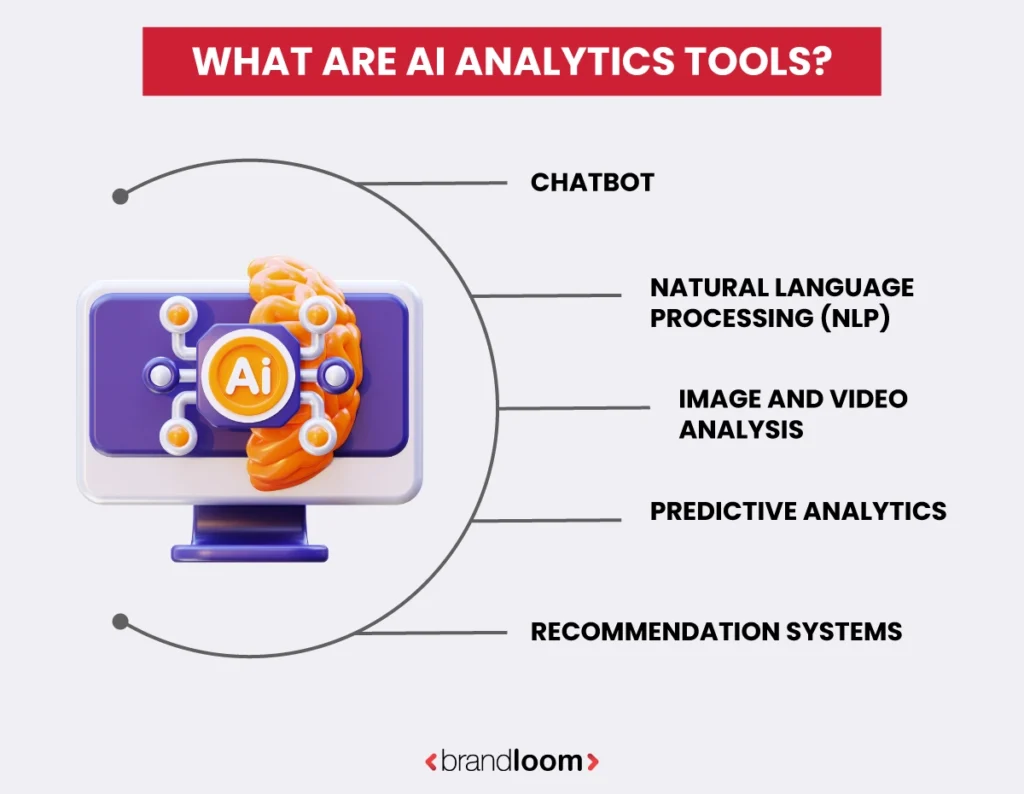
For example, AI can identify hidden correlations between product preferences and regional buying behavior, or predict which users are likely to churn based on real-time engagement data. With built-in predictive analytics, these tools help teams go beyond “what happened” to explore “what’s likely to happen next” enabling proactive, informed decisions.
They’re also becoming more user-friendly. Today’s platforms often support natural language querying, where a user can type something like “show me sales trends for Q2” and receive a visual answer instantly. This functionality empowers non-technical teams to explore data without waiting on IT or analytics teams, making data exploration accessible to everyone.
Tools like Google Cloud’s Vertex AI, DataGPT, or Coefficient integrate seamlessly with popular platforms like Google Sheets, CRMs, and cloud databases. These connections allow businesses to centralize data from multiple data sources, clean it automatically through data preparation, and visualize it through smart dashboards—all in one ecosystem.
In short, AI data analytics tools aren’t just for data scientists anymore. They’re becoming essential for any business that wants to extract insights from complex data, act faster, and build a more agile, intelligent organization.
How AI Analytics Tools Work
AI analytics tools aren’t just faster versions of spreadsheets. They’re intelligent systems that automate and enhance the entire analytics process—from data preparation to predictive modeling—so your team can focus on action, not manual work.
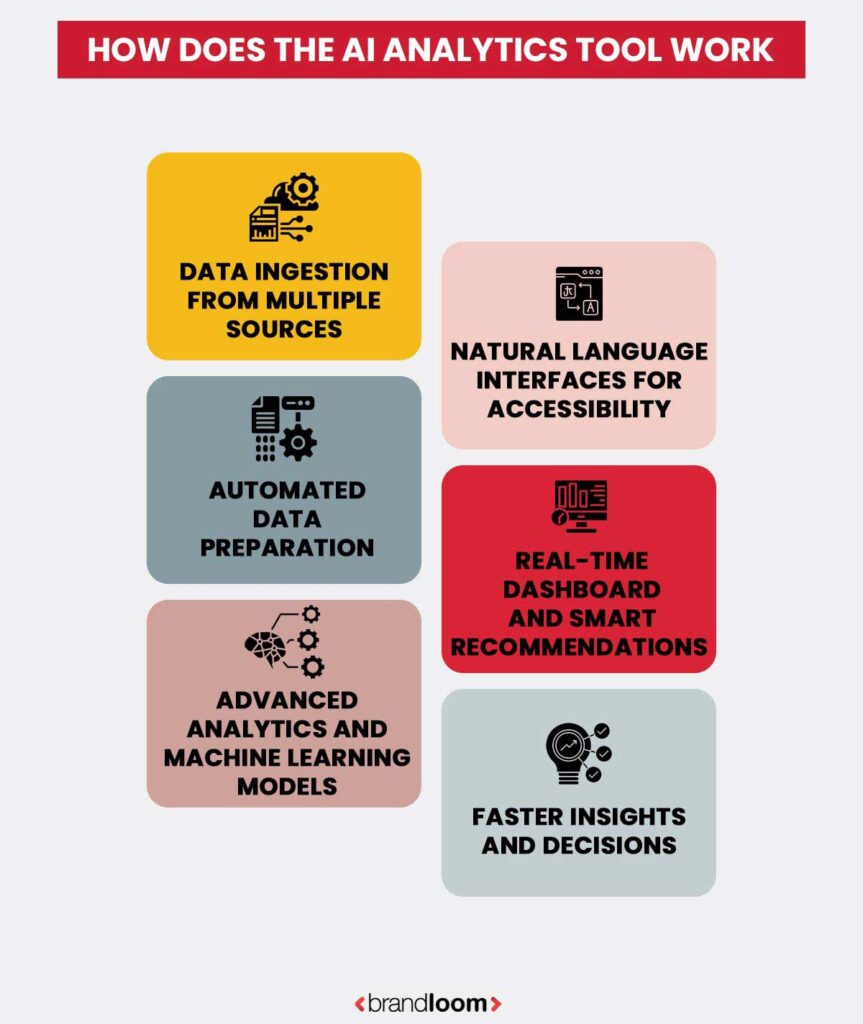
1. Data Ingestion from Multiple Sources
The first step is gathering data from various data sources. This can include CRMs, ERP systems, Google Sheets, cloud databases, customer surveys, and social media platforms. Whether you’re working with structured sales data or unstructured data like emails or support tickets, AI tools bring it all together into one centralized ecosystem.
2. Automated Data Preparation
Cleaning data used to take hours—now AI handles it in minutes. These tools detect and fix inconsistencies, remove duplicates, and standardize formats automatically. With AI-powered data preparation, teams save time and reduce errors. This ensures your analysis is based on clean, reliable input—crucial for any business relying on real-time decision-making.
3. Advanced Analytics and Machine Learning Models
Once the data is prepared, advanced analytics engines go to work. They apply machine learning algorithms to uncover hidden patterns, detect anomalies, and even predict future outcomes. For example, the system might flag declining engagement in a region and recommend a targeted retention campaign. This stage enables powerful predictive analytics—turning raw numbers into foresight.
4. Natural Language Interfaces for Accessibility
What sets modern AI analytics tools apart is ease of use. Most platforms support natural language processing, allowing users to ask questions in plain English—no code required. A sales lead might type, “Show me revenue growth by region this quarter,” and the tool will return charts, trends, and even contextual recommendations.
5. Real-Time Dashboards and Smart Recommendations
These tools don’t just analyze data—they make it actionable. AI-powered dashboards refresh in real time and often include smart alerts. Some tools use generative AI to summarize performance or suggest next steps, such as: “Revenue dropped 15% in Q2—consider retargeting lapsed users with a discount.”
6. From Insights to Decisions—Faster
Ultimately, AI analytics tools streamline the journey from data analysis to business impact. With fewer bottlenecks and faster access to insights, your team can make data-driven decisions without relying on complex reports or technical teams.
Key Capabilities That Set AI Analytics Tools Apart
Affordable AI analytics platforms for startups do more than automate number crunching—they enable organizations to understand what’s happening now, anticipate what comes next, and act with precision. Below are the standout features that make these tools indispensable for data-driven teams.
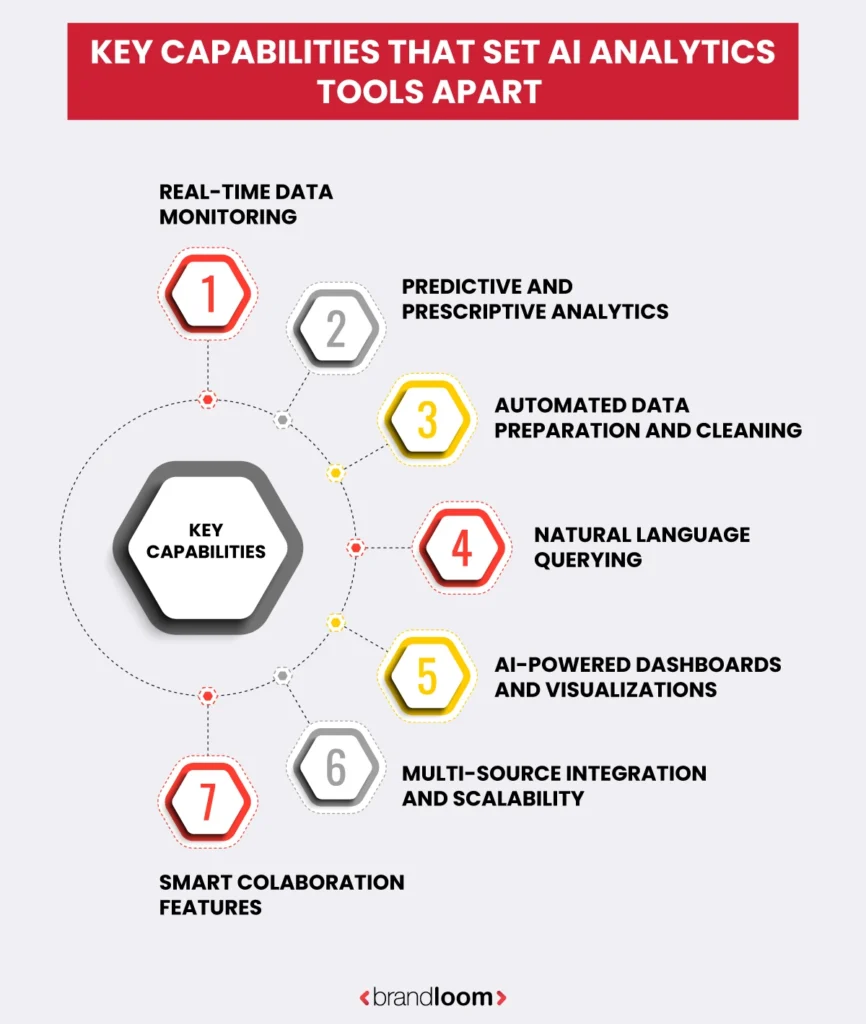
1. Real-Time Data Monitoring
Modern businesses need insights instantly—not days or weeks later. With real-time analytics, AI tools constantly pull and process live data from internal and external sources. This means teams can react to shifts in customer behavior, market trends, or operational inefficiencies as they happen. Alerts and auto-generated insights reduce response time and improve agility.
2. Predictive and Prescriptive Analytics
What if you could forecast customer churn before it happens? Or identify which product will underperform next quarter? That’s the power of predictive analytics. AI models analyze historical data and current patterns to anticipate outcomes. Some tools go further with prescriptive analytics, suggesting the best actions to take next. These capabilities turn your data into a forward-looking strategy engine.
3. Automated Data Preparation and Cleaning
Preparing data for analysis often takes longer than the analysis itself. AI dramatically reduces this time by automatically detecting missing values, correcting inconsistencies, and normalizing fields across data sets. This ensures cleaner, more accurate inputs without tying up your technical team. In high-volume environments, this feature alone saves hours of effort every week.
4. Natural Language Querying
AI analytics tools make data accessible to everyone—not just data scientists. Thanks to natural language processing (NLP), users can type questions like “What’s the month-over-month growth in the North region?” and receive clear visual answers. This capability democratizes data exploration and speeds up decision-making across departments.
5. AI-Powered Dashboards and Visualizations
Today’s tools don’t just display data—they interpret it. AI-powered dashboards highlight trends, outliers, and opportunities automatically. Dynamic visualizations update in real time and adapt to what matters most for your goals. Whether it’s campaign ROI or warehouse efficiency, these dashboards keep decision-makers focused on what truly drives results.
6. Multi-Source Integration and Scalability
Whether you’re pulling data from spreadsheets, APIs, cloud apps, or customer platforms, AI tools support seamless data integration. They unify fragmented data and scale easily as your business grows. This enables centralized, comprehensive reporting across marketing, finance, operations, and more.
7. Smart Collaboration Features
Most platforms now include built-in collaboration tools—annotations, shared dashboards, exportable insights—so teams can align faster. AI even supports generative summaries for executive updates or stakeholder reports, making it easier to turn data into action.
Together, these capabilities make AI analytics tools more than just smart software—they become an active part of your strategic team. They reduce time-to-insight, unlock smarter forecasts, and ensure every team member can confidently make data-driven decisions.
Top Use Cases of AI Predictive Analytics Software for Enterprises Across Industries
AI analytics tools are reshaping how organizations across industries operate, optimize, and grow. From improving operational efficiency to enhancing customer experiences, these tools are enabling faster, smarter, and more strategic decisions—at scale. Below are some of the most impactful use cases across key sectors.
1. Retail & E-commerce: Personalization and Demand Forecasting
Retailers deal with massive volumes of transaction and behavioral data. AI analytics helps make sense of it all. These tools track real-time buying behavior, uncover customer preferences, and enable dynamic segmentation. By analyzing patterns, AI suggests personalized offers, product bundles, or targeted content—maximizing conversions.
They also improve inventory management. With predictive analytics, businesses can forecast demand, reduce overstocking, and avoid stockouts—especially during peak seasons.
2. Healthcare: Diagnostics and Operational Efficiency
In healthcare, data is everywhere—electronic medical records, lab results, patient feedback, insurance claims. AI analytics tools can process both structured and unstructured data to improve clinical decision-making. They flag anomalies in test results, predict disease risk, and even assist in treatment planning.
Operationally, hospitals and clinics use AI to streamline scheduling, reduce wait times, and optimize resource allocation—ensuring better patient care and cost management.
3. Finance & Banking: Risk Assessment and Fraud Detection
Banks and financial institutions rely heavily on real-time insights. AI analytics tools analyze transaction data to detect unusual activity, enabling fraud detection in seconds rather than hours. Risk models built on machine learning can score customer creditworthiness more accurately than traditional methods.
These tools also help in investment analysis and portfolio optimization—helping financial advisors make data-driven decisions faster.
4. Manufacturing: Predictive Maintenance and Quality Control
Downtime is costly in manufacturing. AI analytics tools help predict equipment failures before they happen by analyzing sensor data from machinery. This minimizes disruptions and reduces maintenance costs.
They also play a crucial role in quality control. By monitoring production data in real time, AI systems can detect deviations from product specs and recommend corrective actions—ensuring consistent output and customer satisfaction.
5. Education: Performance Tracking and Course Optimization
Educational institutions are using AI to analyze student behavior, test results, and feedback. These insights help personalize learning paths, identify struggling students early, and improve retention rates.
At an administrative level, schools and edtech platforms use AI to track program effectiveness and optimize course offerings based on learner engagement and outcomes.
6. Logistics and Supply Chain: Route Optimization and Inventory Planning
AI analytics in logistics helps companies monitor delivery timelines, optimize routes in real time, and predict shipment delays. It integrates weather, traffic, and inventory data to minimize bottlenecks and improve customer satisfaction.
In warehousing, AI tools recommend restocking schedules and identify slow-moving inventory—enabling leaner, more efficient operations.
Across every sector, AI analytics tools are enabling teams to act faster, personalize deeper, and predict outcomes with confidence. By aligning real-time insights with strategic goals, businesses are turning raw data into lasting competitive advantage.
Must-Have Features to Look for in AI Analytics Tools
Choosing the right AI analytics tools can shape the speed, accuracy, and value of your decision-making process. But not all tools are created equal. Whether you’re scaling up internal analytics or aiming for enterprise-wide data intelligence, these are the features that matter most.
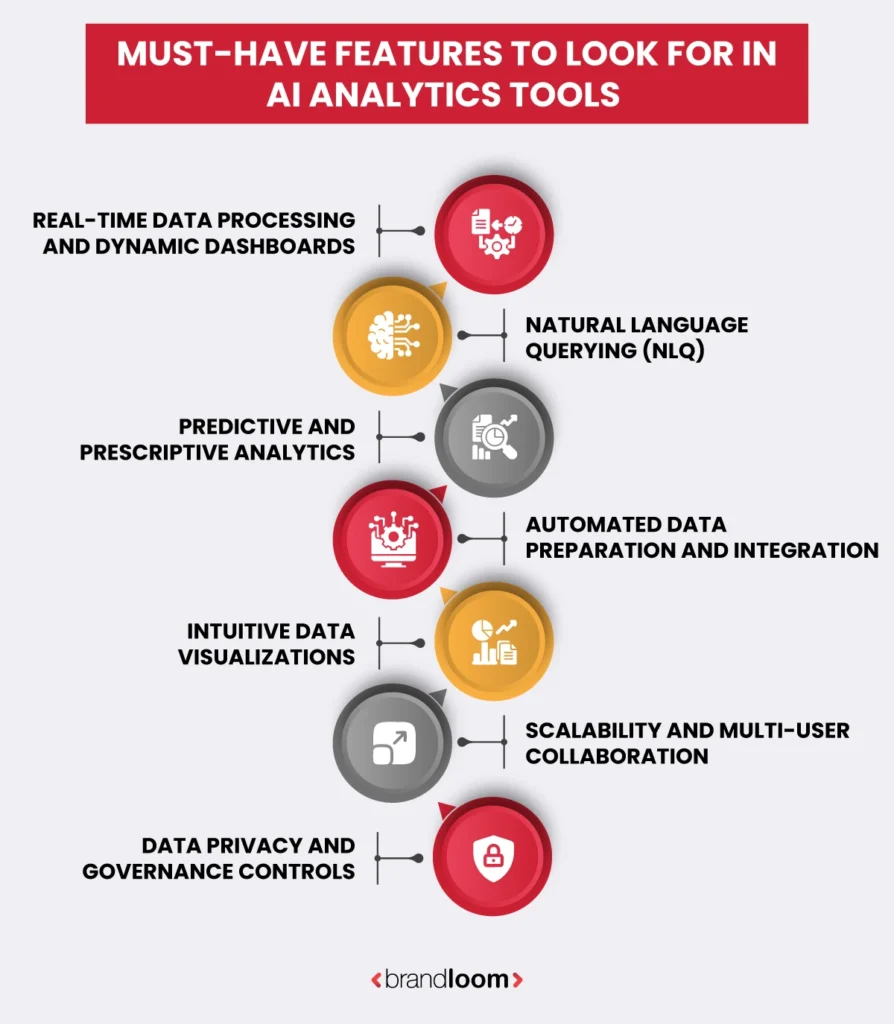
1. Real-Time Data Processing and Dynamic Dashboards
In fast-moving environments, real-time insights are non-negotiable. Your tool should continuously analyze data as it flows in from various sources—CRM platforms, sales systems, IoT sensors, or Google Sheets. Real-time processing allows you to spot shifts in behavior, campaign performance, or customer activity instantly.
Dashboards should be more than static reports. Look for AI-powered dashboards that update automatically, prioritize anomalies, and let teams explore live metrics with filters and drill-downs. This keeps decision-makers connected to the present—and ready to act.
2. Natural Language Querying (NLQ)
AI analytics tools should be usable by everyone—not just data scientists. With natural language processing, team members can type queries like “What’s our Q2 revenue trend in North America?” and get instant, visual responses.
This accessibility democratizes analytics. Marketers, product managers, and C-level executives can all run their own queries, reducing delays and freeing up technical teams for more complex tasks.
3. Predictive and Prescriptive Analytics
Static dashboards only tell you what happened. The best tools tell you what’s likely to happen next—and what to do about it. With predictive analytics, AI models analyze historical patterns and surface forecasts: sales dips, churn probability, or demand spikes.
Advanced platforms also offer prescriptive analytics that recommend next steps based on those predictions. For example: “Customer churn risk is high—deploy retention email flow” or “Ad performance is falling—lower bids on mobile.” These insights drive smarter, faster decision-making.
4. Automated Data Preparation and Integration
The average analyst spends over 60% of their time cleaning data. Leading AI analytics tools minimize that effort with automated data preparation. They handle formatting, deduplication, error correction, and merging—turning messy inputs into clean, analysis-ready data sets.
Equally important is seamless integration with data sources. The tool should connect easily to cloud storage, SQL databases, APIs, marketing platforms, and spreadsheets—so you can centralize insights across all departments.
5. Intuitive Data Visualizations
Data isn’t useful unless it’s understandable. Choose platforms that offer dynamic, interactive data visualizations that simplify complex relationships and trends. Good visualization goes beyond charts and graphs. It highlights key KPIs, compares timelines, and visualizes outliers—making patterns easy to spot and act on.
Many AI platforms now include generative AI features that convert data into written insights. For example: “Sales grew 12% in Q3, driven by a 25% increase in repeat customers.” These summaries improve executive visibility and reporting efficiency.
6. Scalability and Multi-User Collaboration
As your data grows, so should your tools. Look for platforms that support growing amounts of data and increasing team size. Multi-user access, permission levels, and version control are essential features for enterprise use.
Collaboration tools—such as shared dashboards, comment threads, and alert triggers—ensure alignment across departments. The best AI analytics tools become hubs where teams can explore data together and move faster in sync.
7. Data Privacy and Governance Controls
Security and compliance can’t be afterthoughts. Make sure your analytics platform includes encryption, access controls, and data governance features. Especially in industries like finance or healthcare, AI tools must align with regulations like GDPR or HIPAA.
Look for audit logs, role-based access, and data masking features that let your teams work with sensitive information responsibly.
When selecting a platform, don’t just chase features. Map them back to your goals—whether that’s improving conversions, reducing churn, forecasting inventory, or speeding up internal reporting. The right AI analytics tools will enhance every layer of your business—from insights to action.
Emerging Trends in AI-Powered Analytics
The world of AI analytics tools is evolving fast—reshaping how businesses collect, interpret, and act on data. As enterprises grow more data-driven, these emerging trends are pushing AI analytics into new territory, delivering faster, deeper, and more intuitive insights across teams. Here’s what’s transforming the space right now.
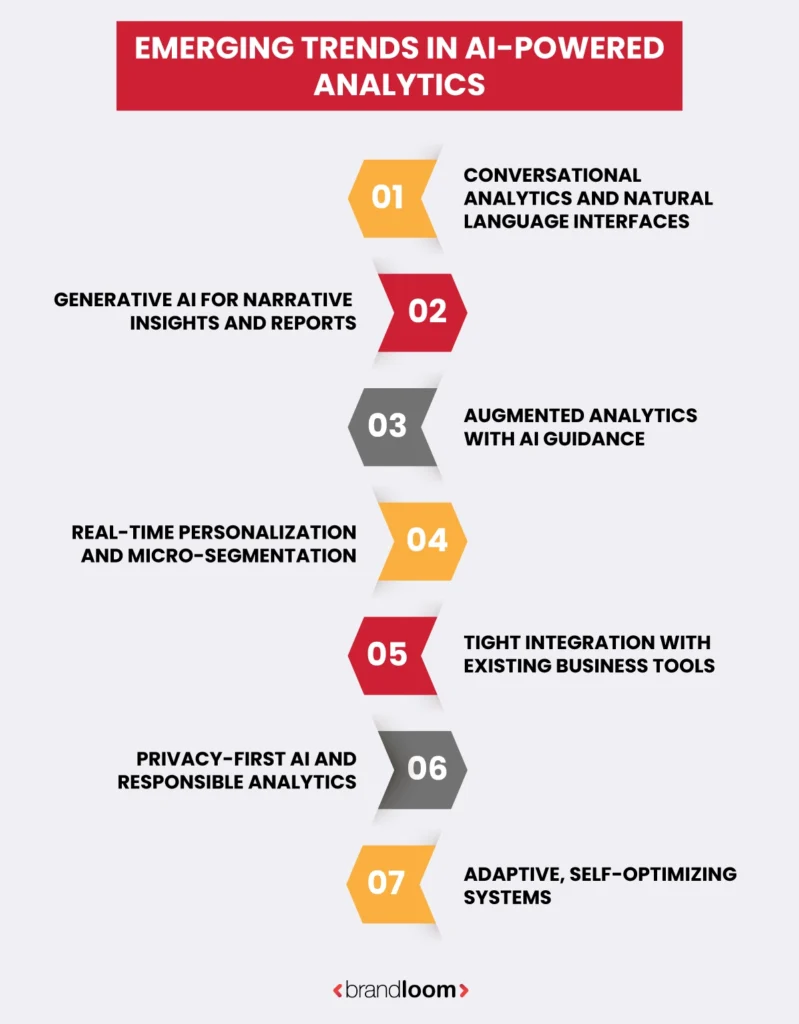
1. Conversational Analytics and Natural Language Interfaces
The biggest barrier to data exploration used to be technical know-how. That’s changing fast with natural language processing (NLP) and conversational analytics. Today, users can interact with data by asking questions in plain English—and get smart, contextual answers instantly.
This shift makes analytics accessible to every department. From sales to operations, teams no longer need SQL skills or BI dashboards. A marketing manager can ask, “How did our Q2 performance compare to Q1 in the North region?” and receive a visual report in seconds. As NLP becomes smarter, expect even deeper interactions between humans and data systems—driven by dialogue, not dashboards.
2. Generative AI for Narrative Insights and Reports
Generative AI isn’t just for content—it’s revolutionizing analytics, too. Platforms now use generative models to summarize performance, explain trends, and even write executive reports. Instead of interpreting charts manually, users receive AI-generated summaries like:
“Sales in Europe declined 8% last quarter, driven by a 12% drop in new customer acquisition. Retargeting campaigns underperformed in Germany.”
This human-like interpretation turns raw data into actionable insights—fast. It saves time, improves clarity, and ensures leadership always gets a clear story behind the numbers.
3. Augmented Analytics with AI Guidance
Augmented analytics is all about making analytics smarter—and more supportive. Instead of waiting for you to ask the right questions, AI proactively highlights unusual patterns, correlations, or risks.
For example, your AI analytics tool might detect that customer churn is rising in a specific segment and recommend actions like a loyalty campaign or price adjustment. Some platforms even run automated A/B tests, tracking impact over time and adjusting strategies based on results.
This intelligent, guided analysis reduces the need for constant manual exploration and supports data-driven decisions at scale.
4. Real-Time Personalization and Micro-Segmentation
Personalization isn’t new—but real-time, AI-powered personalization is a game changer. With the ability to process data in real time, AI tools can dynamically adjust marketing messages, content, pricing, or offers based on a user’s live behavior.
AI also enables micro-segmentation—going beyond broad demographic buckets to identify behavioral, psychographic, or lifecycle-based audience groups. These smaller, smarter segments make targeting more precise and marketing more effective.
In sectors like e-commerce, media, and SaaS, this trend is driving serious ROI improvements.
5. Tight Integration with Existing Business Tools
Modern AI analytics platforms aren’t siloed systems—they’re becoming tightly embedded across the business stack. From Google Sheets and Slack to CRMs, data lakes, and cloud storage, AI tools now connect seamlessly across teams and workflows.
This means you can push predictive insights directly into your sales platform, trigger marketing automations based on campaign performance, or alert support teams when product engagement drops. These integrations transform analytics from a back-office function into a real-time operational engine.
6. Privacy-First AI and Responsible Analytics
As AI analytics tools grow more powerful, businesses are being held to higher ethical standards. With increasing scrutiny over data usage, responsible AI is emerging as a key trend.
Modern platforms now include data governance controls, role-based access, anonymization tools, and audit trails to ensure compliance with GDPR, HIPAA, and other regulations. There’s also a growing emphasis on explainable AI—making model decisions transparent, not black boxes.
For industries like finance, healthcare, and education, these features are no longer optional—they’re essential for trust and adoption.
7. Adaptive, Self-Optimizing Systems
Finally, the most advanced AI analytics tools are becoming self-improving. These systems learn from user behavior, refine their algorithms over time, and personalize recommendations based on individual preferences and outcomes.
For example, if a marketing manager repeatedly asks about ad performance by channel, the platform might begin highlighting those insights proactively or auto-generating weekly snapshots. This adaptiveness reduces cognitive load and allows teams to focus on decision-making instead of dashboard navigation.
In short, the future of AI data analytics is real-time, conversational, personalized, and deeply integrated into daily operations. The businesses that embrace these trends early will move faster, operate smarter, and unlock competitive advantages that laggards simply won’t match.
AI Analytics Tools Comparison: Popular Marketing Platforms to Know
With dozens of AI-powered platforms on the market, choosing the right solution can feel overwhelming. While your decision should align with business size, data complexity, and integration needs, certain tools stand out for their capabilities, ease of use, and innovation. Below is a breakdown of leading AI analytics tools worth exploring—along with what makes each one unique.
In this section, we’ll explore five of the most talked-about AI analytics platforms. Each one has its own strengths, whether it’s white-labeled dashboards, scalable data reporting, automated collection, multi-client management, or cross-channel attribution. We’ll break down their features, highlight the pros and cons, and wrap up with a comparison table so you can quickly see which one fits your needs.
1. AgencyAnalytics — Best for White-Labeled Dashboards
AgencyAnalytics is a reporting platform built with agencies in mind. It shines when you want to deliver client-ready dashboards that look professional and fully branded. With built-in SEO, PPC, and social media integrations, it saves agencies hours of manual reporting every month.
Features
- Fully white-labeled dashboards and reports with branding options
- Over 60 integrations (Google Ads, Facebook Ads, SEO tools, etc.)
- Client portal access and automated reporting schedules
- SEO rank tracking and site audit tools
Pros
- Clean, user-friendly dashboards clients understand instantly
- Saves time with automated reporting
- Strong white-labeling helps agencies showcase their brand
Cons
- Costs rise as client numbers grow
- Limited data transformation options compared to enterprise tools
- Some niche integrations are missing
2. Improvado — Scalable Reporting on Complex Data Stacks
Improvado is built for large teams and enterprises managing massive data volumes across multiple platforms. It centralizes marketing and sales data, making it easier to track ROI and unify complex reporting.
Features
- 500+ data connectors for ads, CRMs, and analytics platforms
- Advanced data transformation and cleaning
- Integration with BI tools and data warehouses (Snowflake, BigQuery, etc.)
- Data governance, anomaly alerts, and quality checks
Pros
- Handles high-volume, multi-channel data efficiently
- Excellent for complex reporting and scalability
- Strong customer support with dedicated onboarding
Cons
- Expensive for smaller businesses
- Steep learning curve for non-technical teams
- Pipeline monitoring could be more transparent
3. Adverity — Automating Data Collection
Adverity focuses on streamlining data collection and transformation. It automates tedious data tasks and delivers clean, reliable data pipelines, making it a go-to for companies tired of manual spreadsheet work.
Features
- Automated ETL (extract, transform, load) pipelines
- Hundreds of connectors and destination options
- Data quality checks and anomaly detection
- Flexible integration with spreadsheets, BI tools, and warehouses
Pros
- Saves time with automation and reduces errors
- Flexible for technical teams needing customization
- Strong support and onboarding experience
Cons
- Learning curve for setup and data modeling
- Costs increase quickly with scale and connectors
- Some users report occasional data pipeline glitches
4. Funnel — Best for Multi-Client Campaigns
Funnel is a marketing data hub designed with agencies and brands managing multiple campaigns. It pulls data from hundreds of platforms and organizes it into dashboards or exports it to tools like Google Sheets and Data Studio.
Features
- 500+ data source connectors
- Prebuilt data models for marketing reporting
- Centralized dashboards for multi-client campaigns
- Export to BI tools, spreadsheets, and warehouses
Pros
- Great for agencies managing multiple clients
- Transparent integrations with reliable data pipelines
- Easy to manage cross-channel campaign reporting
Cons
- Can become expensive at higher usage levels
- Data transformation features are less advanced.
- Requires training for full efficiency
5. Windsor.ai — Best for Cross-Channel Campaign Management
Windsor.ai stands out for its strong attribution modeling and cross-channel tracking. It’s a favorite among performance marketers who need to understand how different channels contribute to conversions.
Features
- Multi-touch attribution modeling
- Cross-channel tracking across ads, analytics, and CRM platforms
- Flat pricing with inclusive access to connectors
- Easy integration with dashboards and BI tools
Pros
- Affordable compared to other enterprise tools
- Strong focus on attribution and ROI insights
- Quick setup and fast time-to-value
Cons
- Limited in-depth ETL and advanced transformation features
- Some reports may still need external visualization tools
- Real-time updates can lag slightly
| Tool | Best For | Key Features | Pros | Cons |
| AgencyAnalytics | Agencies needing white-labeled dashboards | 60+ integrations, client portals, SEO tools | User-friendly, white-label branding, saves time | Price scales with clients, fewer customizations |
| Improvado | Enterprises with complex data | 500+ connectors, BI & warehouse integration, governance | Scalable, strong support, advanced data handling | Expensive, steep learning curve |
| Adverity | Automating data collection | ETL automation, quality checks, BI integration | Saves time, flexible for technical teams, strong support | Costly, setup complexity, occasional glitches |
| Funnel | Agencies managing multiple clients | 500+ connectors, multi-client dashboards, exports | Reliable, multi-client friendly, transparent integrations | Pricey at scale, limited transformations |
| Windsor.ai | Cross-channel campaign attribution | Multi-touch attribution, CRM/ads integration, flat pricing | Affordable, strong ROI insights, quick setup | Limited ETL depth, external visualization often needed |
How to Choose the Right AI Analytics Tool for Your Business
The rise of AI analytics tools means businesses now have powerful options—but also harder decisions. Not every platform will suit your business model, data maturity, or operational needs. So how do you choose the right one? Below are key factors and questions that help you align tools with outcomes.

1. Define Your Business Goals First
Before jumping into demos or pricing comparisons, get clear on your goals. Ask:
- Are we looking to improve forecasting?
- Do we need real-time dashboards or long-term trend analysis?
- Will the tool support multiple teams (sales, marketing, ops)?
A retail brand may prioritize real-time personalization, while a B2B SaaS company might focus on churn prediction. Let the use case drive your feature shortlist.
2. Evaluate Data Volume and Complexity
Not all businesses deal with massive data sets—but the structure of your data matters just as much.
- Are you working mostly with structured data from CRMs or spreadsheets?
- Or do you also need to analyze unstructured data like reviews, call transcripts, or IoT logs?
If your data is fragmented or comes from varied data sources, choose a platform that supports robust data preparation, ingestion, and cleaning.
3. Consider User Skill Levels Across Teams
AI analytics tools vary in complexity. Some are designed for data scientists and analysts, while others cater to business users with no coding experience.
If your team prefers low-code or no-code platforms, prioritize tools that support natural language querying and drag-and-drop interfaces. This ensures broader adoption across sales, marketing, and operations.
BrandLoom often works with businesses that need cross-functional analytics access, and our advice is always the same: choose tools your team will actually use—not just admire.
4. Look for Seamless Integrations
Your AI tool must fit into your existing tech stack. Whether that means syncing with Google Sheets, your CRM, a cloud database, or ERP system—compatibility is key.
Ask:
- Does the platform offer pre-built integrations?
- Will it require heavy API work?
- Can it handle both historical and real-time data?
The more fluid your data sources, the better your outcomes.
5. Assess Scalability and Pricing Models
As your data grows, will the tool grow with you?
- Can it handle increased data volume?
- Does it support more users, teams, and dashboards over time?
Review pricing tiers. Some platforms charge based on usage (rows processed, users added), while others offer fixed tiers. Make sure you’re not locked into a model that becomes cost-prohibitive as your business scales.
6. Prioritize Security and Compliance
For industries like healthcare, finance, and education, data governance is critical. Look for:
- Role-based access controls
- Audit trails
- Data encryption
- GDPR, HIPAA, or SOC2 compliance
If you’re processing customer data, your AI analytics tool must help you stay secure and compliant.
7. Test the Platform Before You Commit
Most leading AI analytics tools offer free trials or sandbox environments. Use these to:
- Import sample data
- Run queries
- Explore dashboard customization
- Evaluate predictive analytics output
Involve both your technical and business teams in the evaluation. What looks impressive to IT may be confusing to marketing—and vice versa.
8. Check for Vendor Support and Community Resources
Strong documentation, onboarding, customer support, and active user forums can make a massive difference post-purchase. Look for platforms with extensive tutorials, dedicated account managers, or even AI model training support if needed.
At BrandLoom, we often help businesses assess and implement analytics solutions end-to-end. Our advice: pick a partner, not just a product.
Choosing the right AI analytics tool isn’t just about features. It’s about finding a solution that complements your people, processes, and growth path—so insights flow seamlessly and decisions come faster.
Conclusion
In today’s fast-moving, data-saturated world, businesses can’t afford slow insights or guesswork. Whether you’re navigating shifting customer expectations, expanding product lines, or optimizing operations, the ability to turn raw data into real-time, strategic action has never been more critical. That’s where AI analytics tools come in.
They go far beyond traditional reporting. These platforms analyze data from diverse sources, apply machine learning models, and deliver actionable insights—often in natural language, and in real time. With built-in automation, personalization, and forecasting, they help businesses not just understand what’s happening but predict what comes next.
The competitive edge now lies in how well a business uses its data, not just how much of it they have. And the most successful organizations aren’t just using AI as a tool—they’re building data-driven cultures where decisions at every level are guided by insight, not instinct.
As one of India’s leading digital marketing agencies, we’ve seen how the right AI analytics tools can unlock serious growth. At BrandLoom, we don’t just talk data—we turn it into action. Whether you’re scaling a startup or optimizing an enterprise, the right AI strategy today sets you up for smarter, faster growth tomorrow.
AI analytics tools aren’t just the future—they’re the now. The sooner your business adopts them, the sooner you’ll unlock deeper visibility, faster growth, and a more confident strategy.
Frequently Asked Questions
An AI analytics tool uses artificial intelligence to automate data analysis, extract meaningful insights, and support real-time decision-making. Unlike traditional tools that rely on manual inputs and static reports, AI platforms process large volumes of structured and unstructured data, identify patterns using machine learning, and generate interactive dashboards or natural language responses. These tools help businesses make data-driven decisions by simplifying complex analytics processes.
At BrandLoom, we work with businesses to implement AI analytics tools that support growth, optimize operations, and increase campaign efficiency. Whether the goal is to improve marketing performance, forecast demand, or understand customer behavior, the right tool turns raw data into actionable intelligence. AI analytics is not just about automation—it’s about enabling teams to focus on what matters most: strategy, execution, and results. With real-time capabilities, predictive power, and easy usability, AI analytics tools are a must-have in modern digital ecosystems.
AI analytics tools offer businesses faster, deeper, and more accurate insights by automating data preparation, visualization, and prediction. They allow teams to monitor key performance indicators in real time, spot trends before they escalate, and personalize customer journeys with data-backed precision. From reducing manual reporting to improving forecasting, these tools empower every department—marketing, sales, operations, and finance—to make smarter decisions.
At BrandLoom, we help clients deploy AI analytics platforms tailored to their growth goals. For one D2C fashion client, we used predictive analytics to identify high-value customer segments and optimize retargeting, leading to a 27% increase in ROI. These tools also improve team productivity by eliminating guesswork and automating repetitive tasks. Whether it’s a startup or an enterprise, AI analytics makes business intelligence accessible, actionable, and efficient. When integrated properly, these tools become central to scaling success—delivering impact across strategy, execution, and revenue.
The best AI analytics platforms combine speed, intelligence, and usability. Start with real-time data processing, which allows you to monitor metrics live and react quickly. Predictive analytics helps forecast outcomes, while natural language querying makes it easy for non-technical users to ask questions and get instant answers. Look for seamless integration with tools like Google Sheets, CRMs, and cloud databases, along with robust data governance for privacy and compliance.
At BrandLoom, we help businesses evaluate tools based on their unique needs—whether they’re focused on marketing performance, customer behavior, or operational efficiency. Visual dashboards, automated insights, and scalability are also crucial, especially for growing companies. Some tools offer generative AI summaries or alert systems that flag anomalies and suggest optimizations. Ultimately, the right features depend on your business model and data maturity. Our clients succeed when their tools empower teams to act—not just analyze.
Absolutely. AI analytics tools are now more accessible than ever, with no-code platforms and affordable pricing models tailored to small businesses. These tools help startups and SMEs analyze data without hiring full-time analysts, delivering real-time insights and automation that save time and boost productivity. AI can simplify tasks like forecasting, customer segmentation, and campaign performance tracking—turning small teams into smart, data-driven units.
At BrandLoom, we’ve helped D2C startups, solopreneurs, and bootstrapped brands adopt AI analytics platforms with huge success. For instance, one health supplement client utilized AI dashboards to track regional demand patterns and refine inventory decisions, resulting in a 30% reduction in waste. The key is choosing the right tool for your data size, business complexity, and team’s skill set.
With the right setup, even the smallest business can leverage AI for measurable growth—without technical overhead or steep learning curves. The advantage? You scale smarter and faster than competitors who guess.
Yes—and the difference is significant. While traditional analytics tools rely on static dashboards and manual querying, AI analytics tools use machine learning to detect patterns, predict outcomes, and provide real-time insights. They automate data preparation, suggest next steps, and even generate written summaries. The result is a faster, more accurate, and scalable approach to decision-making.
At BrandLoom, we’ve transitioned multiple clients from outdated platforms to AI-powered systems—unlocking deeper insights and freeing up hours of manual work. For example, one B2B service provider improved lead scoring accuracy and campaign attribution by using AI-based segmentation and predictive modeling.
These tools not only reduce operational costs but also enhance marketing efficiency and business agility. Unlike static tools, AI systems learn and improve over time, becoming more valuable the longer you use them. For growth-focused businesses, AI isn’t just an upgrade—it’s a competitive necessity.
AI analytics tools are transforming nearly every industry, but some sectors are seeing especially high impact. In retail and e-commerce, they drive personalized product recommendations, dynamic pricing, and real-time demand forecasting. In healthcare, AI helps analyze diagnostics, patient flows, and treatment outcomes. Finance and insurance firms use predictive models for risk scoring and fraud detection. Even manufacturing benefits with predictive maintenance and supply chain optimization.
At BrandLoom, we’ve implemented AI analytics across diverse verticals—from a whey protein brand tracking regional buying behavior to a B2B SaaS company using predictive churn models. The common outcome? Better decisions, faster responses, and greater ROI. Industries that generate large amounts of structured or unstructured data—like travel, education, telecom, or logistics—gain the most. Whether the goal is operational efficiency or customer growth, AI analytics adapts to fit the use case. Any data-rich business that wants to scale smarter can benefit from this technology.
Not necessarily. Many modern AI analytics tools are built for business users, offering no-code interfaces, drag-and-drop dashboards, and natural language processing so anyone can analyze data without writing code. These platforms make insights accessible across departments—marketing, sales, customer service—so that decision-making is faster and more inclusive.
At BrandLoom, we recommend no-code or low-code platforms to clients who need quick adoption without building a full data science team. For advanced users or data analysts, some platforms do offer deeper customization through Python, R, or SQL. But for most organizations, tools like Tableau, Coefficient, and Julius.ai provide powerful features without technical barriers. The key is choosing a platform that aligns with your team’s skill set. Whether you’re just starting with analytics or already scaling insights across departments, there’s a tool that fits—and BrandLoom helps businesses identify and implement the right one for their needs.
AI analytics tools prioritize data privacy with built-in features like encryption, access controls, anonymization, and audit logs. Many tools are compliant with international standards such as GDPR, HIPAA, and SOC 2, making them suitable for industries that handle sensitive information. Advanced platforms also include role-based access, allowing teams to restrict visibility to only what’s necessary—ensuring security while still enabling collaboration.
At BrandLoom, we assist clients in deploying AI analytics solutions that meet their regulatory requirements without sacrificing speed or usability. For a health and wellness brand, we helped implement a platform with strict user-level permissions and encrypted data channels to safeguard customer profiles. Today’s best tools also log user activity, helping organizations stay compliant while building trust with users. In the age of data responsibility, privacy is not optional—it’s essential. Choosing the right platform means balancing smart insights with secure operations, and BrandLoom ensures you get both.
While AI analytics tools offer immense value, challenges remain—especially for companies new to data-driven decision-making. Common issues include poor data quality, lack of internal expertise, and resistance to changing legacy workflows. Additionally, integrating AI tools into existing systems can be complex if your data sources are siloed or unstructured. Some teams may also struggle to interpret AI-generated insights without training.
At BrandLoom, we guide businesses through these roadblocks with structured onboarding, tool selection, and change management. For example, we helped a mid-size fashion brand clean fragmented e-commerce and CRM data before layering AI-driven insights. The result? A smoother transition and better performance tracking. Other key challenges include data privacy concerns, high expectations, and dependency on third-party platforms. But with the right roadmap and expert support, these issues can be managed—and the long-term rewards of improved agility, forecasting, and efficiency far outweigh the initial friction.
AI analytics tools enhance campaign performance by analyzing large volumes of behavioral, demographic, and contextual data to identify high-performing segments. AI helps personalize messaging in real time, optimize ad placements, and automate bid adjustments based on predicted outcomes. Tools can even test variations of creative or copy to see what resonates best with different micro-audiences.
At BrandLoom, we’ve helped businesses utilize AI to enhance ROAS (return on ad spend), decrease customer acquisition costs, and boost engagement. One client, a B2C wellness brand, utilized AI targeting to tailor Facebook ads by audience persona, resulting in a 35% increase in conversions. AI also reveals insights that aren’t immediately visible, like hidden correlations between time of day and purchasing behavior. Over time, these learnings help you refine your strategy continuously. In essence, AI transforms campaign planning from reactive to predictive, letting brands move faster, spend smarter, and drive more meaningful results.

